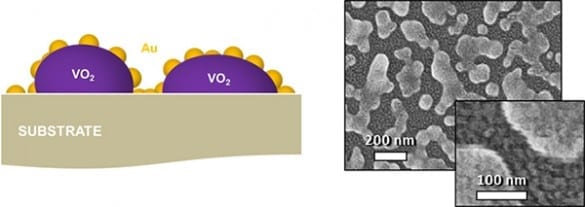
An ultra-fast and ultra-small optical switch has been invented that could advance the day when photons replace electrons in the innards of consumer products ranging from cell phones to automobiles.
The new optical device can turn on and off trillions of times per second. It consists of individual switches that are only one five-hundredth the width of a human hair (200 nanometers) in diameter. This size is much smaller than the current generation of optical switches and it easily breaks one of the major technical barriers to the spread of electronic devices that detect and control light: miniaturizing the size of ultrafast optical switches.
The new device was developed by a team of scientists from Vanderbilt University, University of Alabama-Birmingham, and Los Alamos National Laboratory and is described in the March 12 issue of the journal Nano Letters.
The ultrafast switch is made out of an artificial material engineered to have properties that are not found in nature. In this case, the “metamaterial” consists of nanoscale particles of vanadium dioxide (VO2) – a crystalline solid that can rapidly switch back and forth between an opaque, metallic phase and a transparent, semiconducting phase – which are deposited on a glass substrate and coated with a “nanomesh” of tiny gold nanoparticles.
The scientists report that bathing these gilded nanoparticles with brief pulses from an ultrafast laser generates hot electrons in the gold nanomesh that jump into the vanadium dioxide and cause it to undergo its phase change in a few trillionths of a second.
“We had previously triggered this transition in vanadium dioxide nanoparticles directly with lasers and we wanted to see if we could do it with electrons as well,” said Richard Haglund, Stevenson Professor of Physics at Vanderbilt, who led the study. “Not only does it work, but the injection of hot electrons from the gold nanoparticles also triggers the transformation with one fifth to one tenth as much energy input required by shining the laser directly on the bare VO2.”
Both industry and government are investing heavily in efforts to integrate optics and electronics, because it is generally considered to be the next step in the evolution of information and communications technology. Intel, Hewlett-Packard and IBM have been building chips with increasing optical functionality for the last five years that operate at gigahertz speeds, one thousandth that of the VO2 switch.
“Vanadium dioxide switches have a number of characteristics that make them ideal for optoelectronics applications,” said Haglund. In addition to their fast speed and small size, they:
- Are completely compatible with current integrated circuit technology, both silicon-based chips and the new “high-K dielectric” materials that the semiconductor industry is developing to continue the miniaturization process that has been a major aspect of microelectronics technology development;
- Operate in the visible and near-infrared region of the spectrum that is optimal for telecommunications applications;
- Generate an amount of heat per operation that is low enough so that the switches can be packed tightly enough to make practical devices: about ten trillionths of a calorie (100 femtojoules) per bit.
“Vanadium dioxide’s amazing properties have been known for more than half a century. At Vanderbilt, we have been studying VO2 nanoparticles for the last ten years, but the material has been remarkably successfully at resisting theoretical explanations,” said Haglund. “It is only in the last few years that intensive computational studies have illuminated the physics that underlies its semiconductor-to-metal transition.”
The Latest on: Nanoscale optical switch
[google_news title=”” keyword=”Nanoscale optical switch” num_posts=”10″ blurb_length=”0″ show_thumb=”left”]
via Google News
The Latest on: Nanoscale optical switch
- The Best Optical Gaming Keyboards in 2024on April 28, 2024 at 1:36 am
While optical switches do feature mechanical components, they use light for actuation rather than a physical mechanical connection. Not only is it seriously cool to tell people you type with ...
- The mechanical keyboard switch guideon April 25, 2024 at 5:00 pm
Instead of using metal contacts to trigger the switch these use light or magnets. There are two types of optical switch. The more basic just has the key block or allow a beam of light to pass ...
- All change, pleaseon April 21, 2024 at 2:16 am
Two main hurdles obstruct the nanoscale miniaturization of photonic ... in contrast, when it 'switches on' the optical response of the molecule (for instance, by forcing it into a resonance).
- Roccat's Lightweight Gaming Mouse Is Now Under $25on April 11, 2024 at 5:00 pm
The very capable Roccat Burst Pro with a 19K DPI sensor, optical switches, and more is now selling at an incredible $24.99 on Amazon. One of Roccat's more popular and affordable wired gaming mice ...
- Molecular Switches: Nanoscale Control and Responsivenesson April 6, 2024 at 8:05 pm
Molecular switches are nanoscale devices that can reversibly change their state ... These switches find applications in optical data storage, photopharmacology, and smart materials. Electrochemical ...
- Spontaneous curvature the key to shape-shifting nanomaterials, finds studyon March 4, 2024 at 7:31 am
Nanoplatelets, with their ability to form helical structures, and exceptional optical properties due ... new forms of actuators or switches at the nanoscale. More information: Debora Monego ...
- New Storage Tech Enables Discs with 10,000x the Capacity of Blu-rayon February 23, 2024 at 11:40 am
A research team in China has published their findings on “3D nanoscale optical disk memory,” a new type of storage technology that enables discs with up to a petabit of capacity—24 times the ...
- Nanoscale Horizonson October 18, 2023 at 10:37 pm
Nanoscale Horizons Communications must include a separate ‘new concepts’ statement. This statement should be a paragraph of no more than 200 words and should address the following questions: What new ...
- optical switchon July 1, 2020 at 5:00 pm
Okay, let’s just get this out of the way up front, shall we? This ergonomic mechanical keyboard was a free sample offered to me by X-Bows. They contacted me after I expressed interest in trying ...
- Neaspec GmbHon July 30, 2019 at 8:03 am
“Trusted to deliver cutting-edge solutions for nanoscale optical imaging & spectroscopy for research laboratories in industry and academic institutions” is central to neaspecs’ philosophy. The company ...
via Bing News










